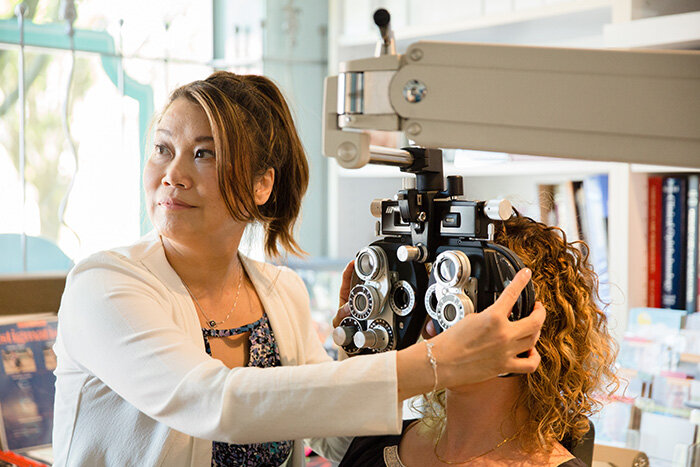A Simple Guide To Understanding Your Eye Prescription
If you feel like you need to “speak” optometry to understand your eye prescription, you are not alone. The puzzling combination of numbers and abbreviations leaves most people feeling lost. What you probably do understand is that this information holds the key to improving your ability to see. Your eye prescription provides the details needed to correct whatever may be standing in the way of you and perfect vision.
So if you need help navigating your prescription, here is a short guide that breaks down everything you need to know.
Do you feel like your prescription doesn't match your eyesight? Schedule a consultation with the experts at Della to have them evaluate your situation.
What Does My Eye Prescription Mean?
The unique combination of abbreviations, numbers, and symbols on your eye prescription are simply the measurements related to different aspects of your vision. They tell vision care specialists what type of lenses you require for proper vision correction. We’ll walk you through a detailed breakdown of each measurement below.
What Do Eye Prescription Abbreviations Mean?
You will notice that your eyeglasses prescription comes with letters that seem to be important information. Here is an explanation of each abbreviation:
OD: This abbreviation stands for oculus dexter, a latin term meaning “right eye”.
OS: These letters are short for oculus sinister, what you would refer to as your “left eye”.
OU: Less often you might see this abbreviation which is short for oculus uterque, a single term used to refer to both eyes.
PD: This abbreviation stands for interpupillary distance, which is the distance from the centre of one eye to the centre of the other eye.
Sphere (S): Measures the strength of your required prescription; often abbreviated as SPH.
Cylinder (C): Speaks to the lens power required for astigmatism correction only. This means that the lens will have no added curvature as opposed to the usual spherical shape.
Axis: Indicates the direction in which your optician needs to position any cylindrical power in your lenses. This is another term that will only be found on prescriptions for those with astigmatism.
Add (short for Reading Addition): This value represents the vision correction requirements on a pair of reading glasses. You will see a number under this column if your doctor has written you a multifocal prescription for bifocal or trifocal glasses. If you see the letters PAL beside the number, this means you are getting progressive lenses which are still under the multifocal lenses umbrella.
Prism: The value under this term indicates the measure of prismatic power which addresses eye alignment issues.
Base: This value indicates the direction of a prism. Prism orientation is noted by “BU” (base up), “BD (base down), “BI” (base in) or “BO” (base out).
What Do The Numbers On My Prescription Mean?
Now that you understand the different abbreviations of your eyeglass prescription, let’s talk about the numbers.
Every eye prescription abbreviation will have a positive or negative number attached to it that indicates the power required for that specific part of the lens that is needed to correct your vision. The numbers inform your optician on how the lenses of your glasses should be cut. These numbers are categorized under the abbreviations or words listed above.
Negative numbers: Your prescription will contain numbers with a minus sign (-), labelled under Sphere (SPH), if you’re nearsighted.
Positive numbers: Your prescription will contain numbers with a plus sign (+), labelled under Sphere (SPH), if you’re farsighted.
The range of numbers will be different under each category. For example, SPH numbers typically range between 0.00 and +/- 20.00 while Cylinder numbers typically range between +/-0.25 and +/-4.00.
Here is the full numbers breakdown:
SPH: Prescription spherical correction ranges between 0.00 and +/- 20.00. The farther away from 0 your prescription is, the stronger the lenses are made to correct vision problems.
Cylinder: For this astigmatism value, the value will usually be between +/-0.25 to +/-4.00. These numbers tell eye care specialists how cylindrical your lenses should be to which focuses light into a line instead of a point.
Axis: For this additional astigmatism value, the value ranges between 1 and 180. The vertical position is represented by the value 90 while the horizontal position is represented by the value of 180.
Add: The additional reading number will range between +0.75 and +3.00. Both eyes will usually require the same value in any set of prescription eyewear.
PD: Pupillary distance for the average adult ranges between 54-74 mm. For kids it’s between 43-58 mm. This lets vision care specialists know where to place the correcting features on your eyeglass lenses.
Prism: This value may go up to 10 and be measured in prism dioptres (p.d.) or in a superscript triangle if the prescription is written by hand.
Base: The direction of the prism will be represented here by the base. Either up, down, in or out.
Understanding Your Contact Lens Prescription
Contact lens prescriptions are different from eyeglass prescriptions because they take different measurements of the eye. If you wear contact lenses, you will need a prescription that is completely separate from your eyeglass prescription.
Contact lens prescriptions will include some of the listed measurements from above such as the OD (right eye) and OS (left eye), their sphere power (SPH), cylinder (C), and axis. Additionally, they will include a Base Curve (BC), a Diameter (DIA), and also the type of contact lens that has been approved by your optometrist.
BC: The base curve is the measurement that indicates the curvature and shape of your contact lenses. Your optometrist measures the steepness or flatness of your cornea during an examination and determines which base curve is best suited for your eye.
DIA: The diameter is the measurement that indicates the length your contacts need to be to completely cover your cornea.
What Is Considered To Be A Bad Eye Prescription?
The higher the SPH number and the farther away from zero it is, both in the negative and positive, the stronger the prescription. A number over 5 is typically considered to be on the stronger end of the spectrum.
But, at Della Optique, we remind our patients that an eye prescription shouldn’t be judged as “good” or “bad”. Instead, think of it as an objective measurement that provides information to help you improve your eyesight.
How Do Eye Doctors Determine Your Prescription?
During a comprehensive eye exam, your eye doctor will test for things like colour blindness, ocular motility (eye movement), depth perception, and more. The portion of your eye exam that determines your prescription is a refraction test.
During a refraction, the optometrist places a device called a phoropter in front of your eyes and shows you a variety of lens choices. They will ask you which of two lenses is clearer. Based on your answers, the eye doctor will continue to refine the lens power until they are able to determine your exact eyeglass prescription.
The refraction determines your level of farsightedness, nearsightedness, astigmatism and more.
The Importance Of Understanding Your Eye Prescription
Knowing how to read your eyeglass prescription is especially essential if you purchase glasses or contact lenses from an online retailer since you will be required to fill in your prescription in their order form. If you can’t make sense of your prescription, this process can lead to your corrective lenses being incorrect, and could lead to distorted vision.
Eyewear Enhancements
Once you have completed an eye exam, obtained your prescription, and chosen your lenses, you will have the option to enhance your glasses. Enhancements like transition lenses to help with UV protection or anti-reflective lenses to reduce glare are all options to consider for your prescription glasses. These features make wearing glasses a little easier and more enjoyable.
Update Your Contact Lens Or Eyeglass Prescription
Because Della Optique is a one-stop solution for those who need glasses or contact lenses, there is no need to decipher your prescription. We conduct comprehensive eye exams, write the new prescription and order your glasses for you.
And even though we start and complete the entire process, we always walk our patients through their eye or contact lens prescription so that they feel well-informed and able to partake in their own eye health decisions—with our guidance, of course.
Visit us online to book your eye exam and find a pair of prescription glasses or prescription sunglasses that will help you see clearly.






